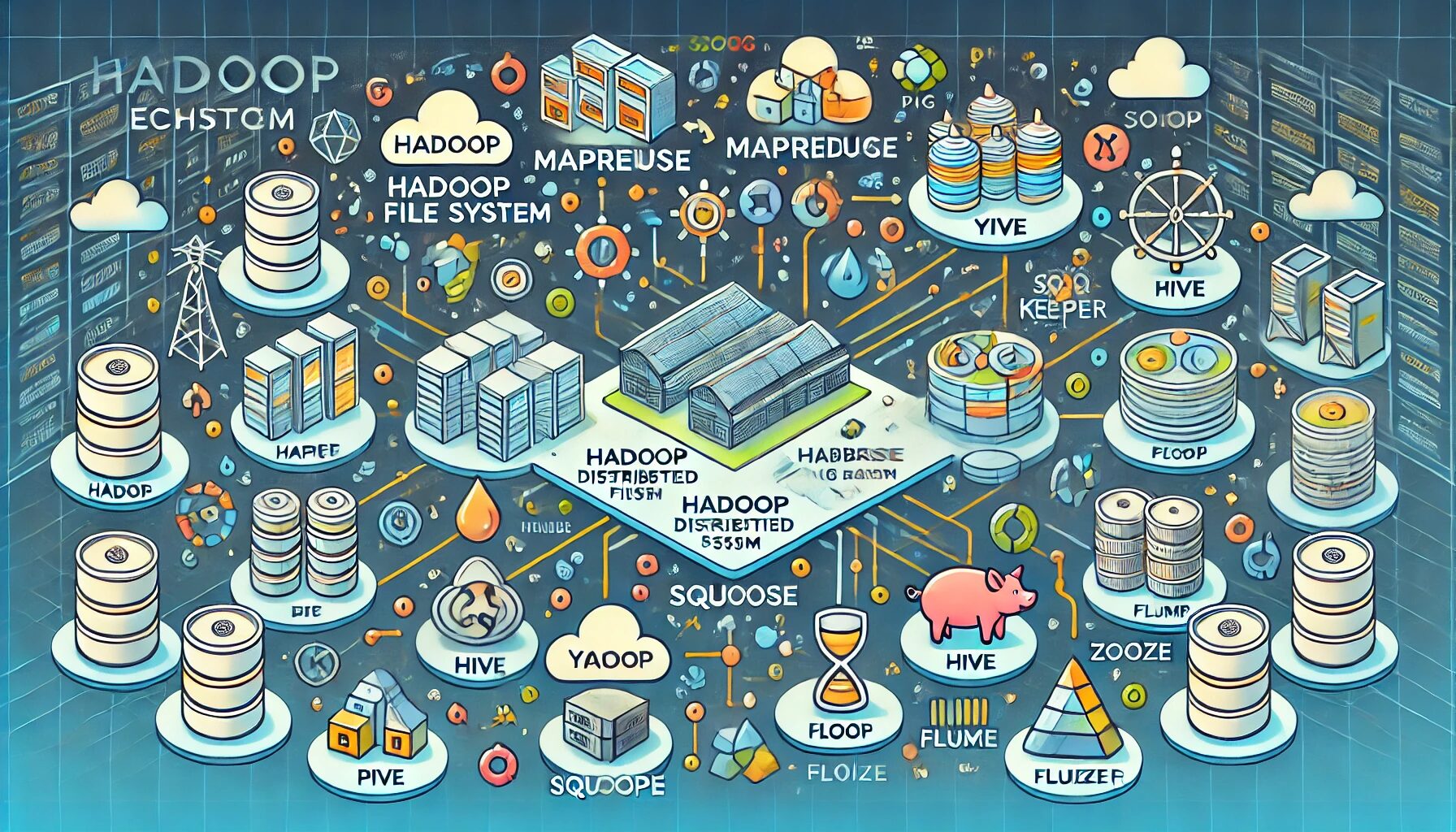Introduction
The Hadoop ecosystem comprises various tools and frameworks designed to handle large-scale data processing and analytics. This paper discusses the core components, namely Hadoop, HBase, and Hive, along with other significant tools such as Pig, Sqoop, Flume, Oozie, and Zookeeper. It aims to elucidate their relationships, appropriate use cases, and effective management practices.
1. Hadoop
Hadoop is an open-source framework for storing and processing large datasets in a distributed computing environment. It includes the following key components:
1.1 HDFS (Hadoop Distributed File System)
HDFS is a distributed file system providing high-throughput access to data. It stores large datasets across multiple machines, ensuring fault tolerance and scalability.
1.2 MapReduce
MapReduce is a programming model for processing large datasets with a distributed algorithm on a Hadoop cluster. It divides the data processing task into smaller sub-tasks that can be executed in parallel.
1.3 YARN (Yet Another Resource Negotiator)
YARN is a resource management layer that manages computing resources in clusters and schedules users’ applications. It enhances the scalability and utilization of Hadoop clusters.
Use Case: Hadoop is ideal for batch processing large datasets, such as log analysis, data mining, and large-scale data processing tasks.
2. HBase
HBase is an open-source, non-relational, distributed database modeled after Google’s Bigtable, running on top of HDFS. It is designed for real-time read/write access to large datasets.
2.1 Column-Oriented Storage
Unlike traditional relational databases, HBase stores data in columns rather than rows. This design enables efficient data retrieval and storage for certain types of applications.
2.2 Scalability
HBase is horizontally scalable, making it suitable for handling large datasets. It allows seamless scaling by adding more nodes to the cluster.
2.3 Consistency
HBase provides strong consistency, ensuring that any read operation returns the most recent write for a given data item.
Use Case: HBase is best used for real-time analytics, online transaction processing, and applications requiring random, real-time read/write access to Big Data.
3. Hive
Hive is a data warehouse infrastructure built on top of Hadoop for providing data summarization, query, and analysis. It uses an SQL-like language called HiveQL.
3.1 HiveQL
HiveQL enables users to write queries similar to SQL, making it accessible to those familiar with traditional relational databases.
3.2 Data Warehousing
Hive supports complex data analysis and summarization, allowing users to perform sophisticated queries on large datasets.
3.3 Integration with Hadoop
Hive translates HiveQL queries into MapReduce jobs, leveraging the distributed processing power of Hadoop.
Use Case: Hive is suitable for data warehousing tasks, business intelligence, and complex data analysis.
4. Other Hadoop-Adjacent Software
4.1 Pig
Pig is a high-level platform for creating MapReduce programs used with Hadoop. It uses a language called Pig Latin, which is a data flow language.
Use Case: Pig is useful for iterative processing, ETL (Extract, Transform, Load) processes, and handling complex data transformations.
4.2 Sqoop
Sqoop is a tool designed for efficiently transferring bulk data between Apache Hadoop and structured datastores such as relational databases.
Use Case: Sqoop is suitable for importing data from relational databases into Hadoop and exporting Hadoop data back into relational databases.
4.3 Flume
Flume is a distributed, reliable, and available service for efficiently collecting, aggregating, and moving large amounts of log data.
Use Case: Flume is ideal for log data collection and aggregation in real-time from various sources to Hadoop.
4.4 Oozie
Oozie is a workflow scheduler system to manage Apache Hadoop jobs. It allows defining a series of actions to be executed in a particular order.
Use Case: Oozie is suitable for managing complex workflows and dependencies in Hadoop jobs.
4.5 Zookeeper
Zookeeper is a centralized service for maintaining configuration information, naming, providing distributed synchronization, and providing group services.
Use Case: Zookeeper is essential for managing the coordination between different Hadoop services and ensuring high availability.
5. Relationship and Integration
The Hadoop ecosystem components work together to form a cohesive framework for Big Data processing and analysis.
5.1 Data Ingestion
Use Sqoop for importing structured data from RDBMS to Hadoop. Use Flume for real-time log data ingestion.
5.2 Data Storage
Store raw data in HDFS.
5.3 Data Processing
Use MapReduce for batch processing, Pig for data transformation, and Hive for data querying and analysis.
5.4 Real-Time Access
Use HBase for real-time read/write access to Big Data.
5.5 Workflow Management
Use Oozie to schedule and manage Hadoop jobs.
5.6 Coordination
Use Zookeeper for distributed synchronization and coordination.
6. Scenario-Based Usage
6.1 Scenario 1: Log Data Analysis
- Ingestion: Flume
- Storage: HDFS
- Processing: MapReduce/Pig
- Analysis: Hive
6.2 Scenario 2: Real-Time Analytics
- Ingestion: Flume/Sqoop
- Storage: HDFS/HBase
- Processing: HBase
- Analysis: Hive
6.3 Scenario 3: ETL Processes
- Ingestion: Sqoop
- Storage: HDFS
- Transformation: Pig/MapReduce
- Analysis: Hive
7. Management and Best Practices
7.1 Resource Management
Use YARN to manage cluster resources efficiently.
7.2 Monitoring
Use tools like Apache Ambari or Cloudera Manager for monitoring the Hadoop cluster.
7.3 Data Backup
Regularly back up HDFS data.
7.4 Security
Implement Kerberos for authentication and use HDFS ACLs and Ranger/Sentry for authorization.
7.5 Performance Tuning
Optimize MapReduce jobs, configure HDFS replication factor, and tune HBase for read/write performance.
Conclusion
Understanding the components of the Hadoop ecosystem and their specific use cases is crucial for designing efficient Big Data solutions. By leveraging the strengths of each component and integrating them effectively, it is possible to build scalable, robust, and high-performance data processing and analytics systems.


